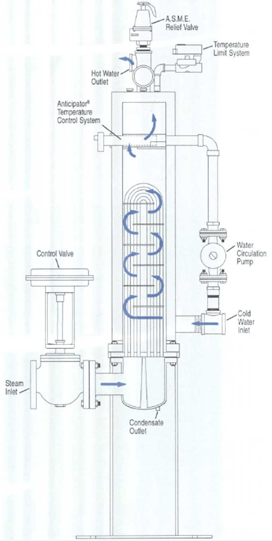
Legionella is a concern for all commercial, health and institutional domestic water systems. This is the bacterium that is linked to Legionnaires’ disease and it is important that all water systems have the correct processes to fight against any possible growth of Legionella bacteria. After Legionella grows and multiplies in a water system, water containing the bacteria can spread in droplets small enough for people to breath in leading to the contracting of legionnaire’s disease. (4) In this Patterson-Kelley blog, we will educate our readers on the main causes of Legionella growth in water systems, the proper way to alleviate the dangers of Legionella, and the efficiency of our COMPACT units Legionella deterring processes.
The key factors to Legionella growth in a domestic water system are sediment and biofilm, temperature, water age and residual disinfectants. (1). The best way to mitigate the danger of Legionella is through maintaining hot and cold water temperatures throughout the entire water system, eliminate sections of no or low water flow, keeping water temperatures above 120°F and using appropriately sized water heaters that are fitted with recirculating pumps to maintain flow and avoid temperature gradients.(1)

Patterson-Kelley’s COMPACT units have been mitigating Legionella for over 60 years. Our original designs included an on board circulating pump and easy temperature controls. An on board circulating pump makes sure that there are no temperature gradients throughout the entire water heating area as well as reduces scale and sedimentation inside of the unit by maintaining constant flow. The temperature controls on the unit provide consistent temperatures +/-4F which allows for sustained temperatures above bacterial growth ranges.
In addition, we insulate all of our units to the most current ASHRAE standards to reduce any heat loss and help with eliminating temperature gradients. (2) Our have a recommended minimum set temperature of 140°F to make sure that legionella has nowhere to grow as legionella grows in water between 77-113°F. (1,2) For extended shutdown periods we always recommend draining the unit so that you don’t have stagnating water and we supply a drain at the lowest point in the shell. (3)
We also supply water quality considerations for hardness so that you can know if you need to soften your system water, reducing biofilm or scaling on the bundle of the COMPACT. (3) PK provides our representatives with an automated sizing program so that they can appropriately size a water heater and not provide a unit that is too large for the application. (1,2) Oversizing a heater can lead to low flow issues as well as issues with the unit short cycling the steam or hot water control valves. (2)
Legionella can be an issue in all water heating systems but Patterson-Kelley has been helping mitigate this for over 60 years. If you wish to learn more about Legionella and our Patterson-Kelley COMPACT unit, please visit the links listed below for more information.
- https://www.cdc.gov/legionella/wmp/contrsol-toolkit/potable-water-systems.html
- https://www.pattersonkelley.com/solutions/water-heaters/indirect-fired/p-k-compact/
- https://www.pattersonkelley.com/uploads/2018/04/1004905925-P-K-Compact-Manual-Rev-C-Jan-2020.pdf
- https://www.cdc.gov/legionella/about/causes-transmission.html#:~:text=After%20Legionella%20grows%20and%20multiplies,air%20that%20contain%20the%20bacteria.

